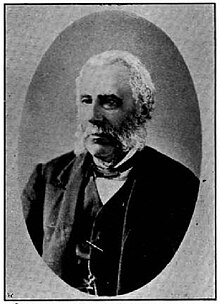John Turnbull Thomson

John Turnbull Thomson (10 August 1821 – 16 October 1884) was a British civil engineer and artist who played an instrumental role in the development of the early infrastructure of nineteenth-century Singapore and New Zealand.[1] He lived the last 28 years of his life in New Zealand, and prior to that fifteen years in the Malay Straits and Singapore.
Biography
Thomson was born at
Thomson arrived in the
He was responsible for the design and construction of a number of notable engineering works including bridges, roads, and hospitals. He conducted the allotment
In 1853 his health failed and he returned to England, where he studied modern engineering techniques, and travelled widely through Britain and the Continent inspecting engineering works. Early in 1856 he emigrated to New Zealand, where he worked as Chief Surveyor of the Otago Province until 1873. From 1876 until 1879 he was Surveyor-General of New Zealand. He was also the original surveyor of the city of Invercargill.[2]
Legacy in Singapore
During his government service in Singapore, Thomson was responsible for many projects:
- Thomson's 1852 report on Singapore's water supply led in 1862 to approval of the Thomson Reservoir, now MacRitchie Reservoir.
- He made an elaborate survey of the Tombs of the Malayan Princes.
- He carried out repairs and lowering of Coleman Bridge.
- He was the architect and builder of:
- Horsburgh Lighthouse on Pedra Branca,
- Hajjah Fatimah Mosque,
- the St. Andrew's Cathedral,
- Dalhousie Obelisk, a monument,
- European Seaman's Hospital,
- the first bridge across the Kallang River, known as Thomson Bridge, and
- Tan Tock Seng Hospital at Serangoon Road.
Several extant places, roads and buildings in Singapore are named after J.T. Thomson. These include:
Area
- Thomson, a region in central Singapore
Roads

- Thomson Road, the arterial road that runs through the Thomson area
- Jalan Lembah Thomson
- Old Upper Thomson Road
- Thomson Close
- Thomson Green
- Thomson Heights
- Thomson Hill
- Thomson Hills Drive
- Thomson Ridge
- Thomson Terrace
- Thomson View
- Thomson Walk
- Upper Thomson Road
Amenities
- Thomson Medical Centre
- Thomson/Whitley Park
Legacy in New Zealand
He was also a keen amateur painter of
From a topographical viewpoint his paintings are of great interest today.Thomson married Jane Williamson of Dunedin at "Kaikorai Bank", Dunedin on the 7 October 1858.[4] He died at his home in Invercargill on 16 October 1884.

Thomson was responsible for the planning of the city of Invercargill in Southland, New Zealand and his mausoleum is in the St. John's Cemetery in Waikiwi, Invercargill. He surveyed many South Island towns prior to development. His descendants have written numerous books which contain authoritative information on his life in New Zealand. Thomson's great-grandson, John Hall-Jones, was a historian specializing in the history of southern New Zealand.[2]
References
- ^ http://digital.otago.ac.nz/results?lcreator=Thomson,%20John%20Turnbull&PHPSESSID=068e70c223902799 Archived 24 July 2011 at the Wayback Machine...
- ^ Southland Times. Retrieved 15 December 2015.
- ^ Thomson as a painter https://eclecticlight.co/2021/02/18/painting-within-tent-john-turnbull-thomson-painted-all-he-surveyed/
- ^ Papers Past, Otago Witness, 16 Oct 1858, p.5
Sources
- Victor R Savage, Brenda S A Yeoh (2003), Toponymics – A Study of Singapore Street Names, Eastern Universities Press, ISBN 981-210-205-1
Further reading
- John Turnbull Thomson, Extracts from a journal: kept during the performance of a reconnaissance survey of the southern districts of the province of Otago, New Zealand, s.n., 1858.
- John Turnbull Thomson, Sketch of the Province of Otago: A Lecture, Being One of the Series Delivered at Dunedin, W. Lambert "Otago Colonist" Office, 1858.
- John Turnbull Thomson, An Outline of the Principles and Details Connected with the Colonial Survey of the Province of Otago, Otago Witness, 1891.
- William Thomas Locke Travers, Walter Baldock Durrant Mantell, Richard Taylor, Fraser (Capt.), Gilbert Mair, W. D. Campbell, Johann Friedrich Heinrich Wohlers, James West Stack, A. C. Baines, William Colenso, John Turnbull Thomson, Julius von Haast, The Māori, 1871.
- John Turnbull Thomson, An Exposition of Processes and Results of the Survey System of Otago, Henry Wise & Company, 1875.
- John Turnbull Thomson, Exploration and Travel in New Zealand, Royal Scottish Society of Arts, 1878.
- John Turnbull Thomson, On the Cleansing of Towns, 1879.
- John Turnbull Thomson, Ethnographical Considerations on the Whence of the Maori, Transactions of the New Zealand Institute, 1871.
- John Turnbull Thomson, Rambles with a Philosopher, Or, Views at the Antipodes, Mills, Dick & Company, 1867.
- Singapore site about Thomson in English https://eresources.nlb.gov.sg/infopedia/articles/SIP_818_2005-01-22.html
